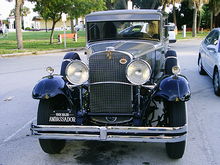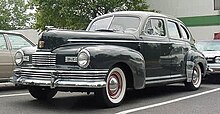Nash Ambassador
Nash Ambassador was the name of the largest range of Nash Motors models between 1932 and 1957. From 1958 to the end of the 1974 model year, the Ambassador was a product of American Motors Corporation , which also used the name for its luxury model range. From 1927 to 1932, the Ambassador was the highest quality equipment line in the largest Nash models.
"Ambassador" limousine (1927 - early 1932)
Nash Motors first used the Ambassador name in 1927 for a particularly well-appointed, 5-seat, 4-door, 5-seater sedan from the Advanced Six (also known as the 267 model). As the most expensive model in the series, the Ambassador had the best upholstery fabrics and other elegant equipment details, which led to a base price of US $ 2,090. In 1929 the Ambassador gave up the role of the most expensive Nash automobile to a 7-seater limousine or a 7-seater Pullman, which was manufactured until 1934.
The Ambassador remained part of the "Advanced Six" series until 1930. Then the new "Nash Twin Ignition Eight" was given the name. In 1931 this car was simply renamed "Eight-90".
Nash Ambassador (mid-1932–1948)
In mid-1932, Nash introduced the Ambassador Eight as a stand-alone model range, which was offered in a number of body designs - including a Coupé and Victoria. With wheelbases of 3378 mm and 3607 mm and expensively equipped, these vehicles were apostrophized as the “ Duesenbergs from Kenosha ” because of their high quality, their great durability, their styling and their high speed . They were part of the second series that Nash brought out in 1932, which included completely new bodies and technical improvements on all vehicles manufactured by the company. With the exception of General Motors , Nash was the only US automaker to make a profit in 1932. In 1934, Nash introduced a new styling - called "Speedstream" - which included extensive decorations on body parts and fenders in the style of Art Deco . Only a few 4-door sedan versions were offered by the Ambassador Eight this year. In 1935 another facelift was carried out with even more decorations and a 2-door sedan was also offered. The car now had a shorter wheelbase of 3,175 mm and the smaller engine of the previous Advanced Eight model . The huge classic shapes of the years 1930–1934 were forever a thing of the past for Nash.
While the Ambassador was only available with Nash's eight-cylinder in-line engine from mid-1932 to 1935 , the 1936 Ambassador Six also featured Nash's largest in-line six, in a 3073 mm wheelbase model previously known as the Advanced Six . Nash merged in 1937 with the Kelvinator Corporation and Charlie Nash's hand-picked successor, George W. Mason , became President of the new Nash-Kelvinator Corporation. In the same year, the coupes and convertibles returned to the Ambassador series. Since 1935, the large Nash models had similar bodies built on the longer chassis, as well as the same hoods , fenders (and certain ornaments) that distinguished the more expensive eight-cylinder from the cheaper six-cylinder. In early 1937 even the cheap LaFayette was included in this scheme. This principle was used until the last AMC Ambassador in 1974, with the exception of the years 1962–1964, when the Rambler Ambassador and the Rambler Classic had the same chassis and the same vehicle front.
Only in model year 1941 did all Nash models with long and short chassis bear the name Ambassador. The Nash Ambassador 600 with a wheelbase of 2845 mm was the first mass-produced automobile with a monocoque construction. From 1941 to 1948, the Nash Ambassador were built with this monocoque construction (frame and body welded) built on a conventional second frame, which made them incredibly stiff and solid automobiles. The Ambassador 600 from 1941 was also the only Ambassador that was powered by a side-controlled motor (L-Head). In the (war-related) short model year 1942, Nash stayed with this design, although the 600 was no longer called the Ambassador.
As ordered by the US government, Nash stopped car production during World War II (1942–1945). When production resumed after the war, there were no more eight-cylinder models in the model range. The 1946 Ambassador Six was now Nash's largest model.
In the area of the Soviet occupation zone, a copy of an Ambassador is said to have served as a template for an in-house development ( Horch 920 S) in 1948 . However, only two prototypes were made in 1950 (" IFA Werk VEB Horch").
1949-1951
Nash continued to use the name Ambassador for his best-equipped models from 1949–1957. George Mason , president of the Nash-Kelvinator Corporation , was an outspoken proponent of aerodynamics in vehicle construction, and so the post-war ambassador is best known for its faired front wheels. When Nash launched his new Airflyte design, Ambassador sales increased significantly, with only 2- and 4-door sedans being offered from 1949 to 1951. The Airflytes also had completely foldable seats, with which one could turn such a car into a sleeping place for 3 adults. But this also gave the car the dubious reputation of being the first choice for teenagers in the 1950s. The Ambassador from 1950 was the first car that did not come from GM and was equipped with a GM Hydramatic automatic transmission.
Mason thought the greatest market opportunities for Nash lay in a product range that was not aimed at the market segments served by other US automakers - the compact car. The sales of the large Nash models were higher than before the war and Mason started a program for smaller cars, such as the Nash Rambler , which brought the traditional Rambler brand back to life.
Trivia: A Airflyte is in the video clip Back for Good of the British pop - band Take That to see.
1952-1957
The Nash Ambassador was last redesigned in 1952. In 1954 there was only a minor facelift. The Golden Anniversary Pininfarina Nash - designed by Pininfarina - received various design awards. Because of the shortage of materials caused by the Korean War , sales at Nash, like those of the other automakers, fell significantly in 1952. The 1954 “everything must get out” sales war between Chevrolet and Ford damaged many independent automobile manufacturers, including Nash. The Airflytes started in 1955 under director Edmund E. Anderson, heavily redesigned in their final sales season. Panoramic windshields that ran around the A-pillars featured completely new vehicle fronts and rear ends that revealed more of the front wheels than Nash had revealed since his 1949 models. The Ambassador was now available with a V8 engine for the first time. This came from Packard and was interlocked with the Packard Ultramatic automatic transmission.
Nash sent his 1956/1957 models into the race with a completely redesigned rear and offered a range of two- and three-tone paintwork. The 1957 models had double headlights as standard for the first time. While the Ambassador's styling may have suffered a bit, Nash was able to offer the car with the much-touted "Weather Eye" heating and ventilation system to which Nash's modern air conditioning could also be connected. Other US automakers also offered air conditioning in some models, but these had large trunk-mounted expansion units and heat exchangers that supplied air to the vehicle interior through clear plastic tubing and headliner-mounted fans. Nash's air conditioning was cheap, space-saving, and fitted under the hood. It could either distribute fresh air or recirculated air and was only half the cost of other systems.
Nash-Kelvinator merged with the adjacent Hudson Motor Car Co. in April 1954 to form the American Motors Corporation (AMC). Both Nash and Hudson dealers were now selling identical Ramblers, which only differed in their logos. Likewise, the large model lines from Nash and Hudson were resold, while the Rambler represented the new company in the lower market segment. As sales of the Rambler increased, so did the large Nash models, including the Ambassador.
The last Ambassador left the factory in Kenosha in the summer of 1957. Nevertheless, the name Ambassador continued to exist - as a designation for the top models - at Rambler and AMC until 1974.
Web links
- Nash Car Club (English)
- History of the Nash Healey
- Nash in the UK (English) ( Memento of 4 December 2012 at the Web archive archive.today )
swell
- Beverly R. Kimes (Ed.), Henry A. Clark: The Standard Catalog of American Cars 1805-1942. Krause Publications, 1996, ISBN 0-87341-428-4 .
- John Gunnell (Ed.): The Standard Catalog of American Cars 1946-1975. Krause Publications, 1987, ISBN 0-87341-096-3 .
- Horch Automuseum Zwickau, text on the Horch 920S exhibit









